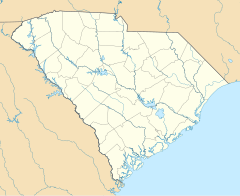Meeting Street Inn
| Meeting Street Inn | |
|---|---|
 Meeting Street Inn | |
| General information | |
| Architectural style | Colonial |
| Location | 174 Meeting Street, Charleston, South Carolina, U.S. |
| Coordinates | 32°46′28″N 79°55′53″W / 32.77444°N 79.93139°W |
| Groundbreaking | 1874 |
| Opening | 1981 |
| Management | Frances F. Limehouse |
| Technical details | |
| Floor count | 3 |
| Lifts/elevators | 1 |
| Design and construction | |
| Developer | Frances F. Limehouse |
| Main contractor | D. A. J. Sullivan |
| Other information | |
| Number of rooms | 56 |
| Parking | Valet and self-parking |
| Website | |
| www | |
The Meeting Street Inn, is in the Charleston Historic District at 174 Meeting Street in downtown Charleston, South Carolina. The building is unusual in its history that dates to 1837 when it was occupied by the Charleston Theatre. In 1874, businessman Enoch Pratt bought the property and built a three-story brick building. It was built in the traditional Charleston style, and had running water piped throughout the building, an innovation for that time. The building turned into the Meeting Street Inn in 1981. The property was acquired by innkeeper Frances F. Limehouse in 1992, who made extensive renovations to develop the Inn as a luxury hotel.
History
[edit]
In December 1837, the Charleston Theatre occupied the two-story building at 174 Meeting Street in downtown Charleston, South Carolina.[1] The building was designed to resemble Karl Friedrich Schinkel's Royal Theatre of Berlin, Germany. The building was destroyed in the widespread Charleston fire of 1861. After the American Civil War, the property laid in ruins for fourteen years. In 1874, businessman Enoch Pratt bought the property and built a three-story brick building with hardwood floors. It was built in the traditional Charleston single-home Colonial style with running water piped throughout the building, an innovation at the time. Pratt divided the property into four lots, and sold two lots to Adolph Tiefenthal, a German immigrant. Tiefenthal hired D. A. J. Sullivan to build a restaurant and saloon, and a showroom for German beers and German wines on the ground floor. The second and third floors housed for the owner and his family.[2][3]
Since then, different businesses occupied the premises, including the Savory Club and Restaurant, Genuine Antiques, Inc., an auto parts store, dental equipment supplier, liquor store, and bicycle shop. In 1981–1982, the property was renovated and enlarged and became the Meeting Street Inn, at a cost of $2.5 million (equivalent to $7,893,103 in 2023). The new addition was built next to the six hotel rooms that were in the original building.[4]
In 1987, the Lexington Group Properties VIII purchased the inn for $3.6 million (equivalent to $9,654,833 in 2023) from Meeting Street Inn Limited Partnership, which was controlled by Franklin G. Gay Jr.[5] After falling into disrepair from Hurricane Hugo in 1989, the property was acquired by Innkeeper Frances "Frankie" F. Limehouse in 1992, who undertook extensive renovations to develop the Inn as a luxury hotel. He had already restored Charleston's Indigo Inn and Jasmine House.[6] The renovations help to bring the modern restoration movement that has transformed Charleston into a popular tourist destination.[2][3][7]
See also
[edit]- List of hotels in the United States
- National Register of Historic Places listings in Charleston, South Carolina
References
[edit]- ^ "Mysterious South Carolina". The Charleston Mercury. Charleston, South Carolina. May 29, 1837. p. 3. Retrieved May 15, 2022.
- ^ a b Dabney, Eric; Coker, Mike (2006). "The Meeting Street Inn". Historic South Carolina, An Illustrated History. HPN Books. p. 37. ISBN 9781893619524. Retrieved May 15, 2022.
{{cite book}}:|work=ignored (help) - ^ a b "History of 173 Meeting Street". www.meetingstreetinn.com. Charleston, South Carolina. Retrieved May 15, 2022.
- ^ "$2.5 Million Inn Opens in Charleston". The State. Columbia, South Carolina. October 15, 1982. p. 57. Retrieved May 15, 2022.
- ^ "Historic Inn in foreclosure". The Index-Journal. Greenwood, South CarolinaCarolina. January 27, 1992. p. 13. Retrieved May 15, 2022.
- ^ "Quaint Inns Offer Alternative Accommodations". The Greenville News. Greenville, South Carolina. December 11, 1983. p. 203. Retrieved May 15, 2022.
- ^ Carmichael, Sherman (April 22, 2019). "The Meeting Street Inn, Charleston". Mysterious South Carolina. Arcadia. p. 37. ISBN 9781439666692. Retrieved May 15, 2022.
{{cite book}}:|work=ignored (help)


